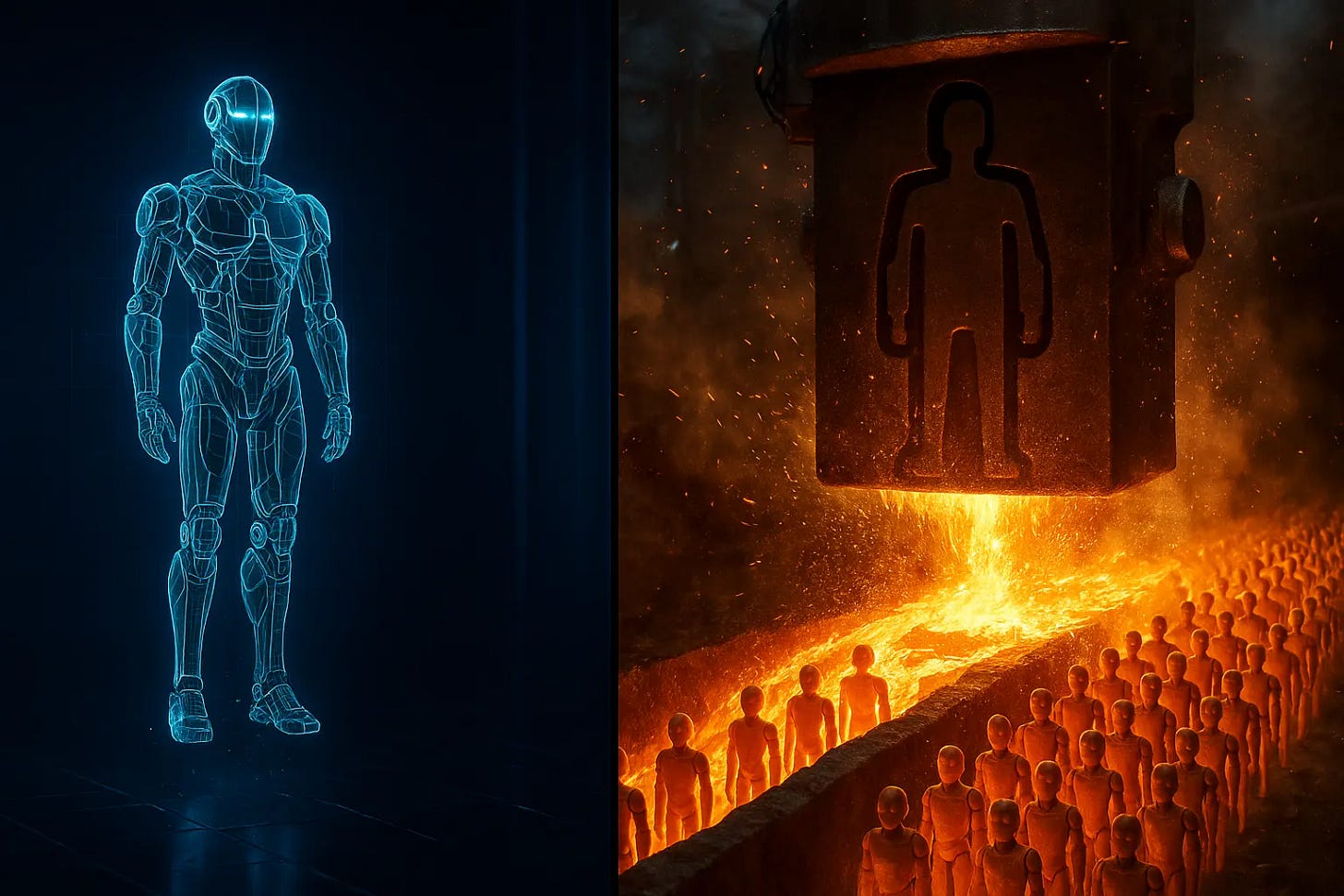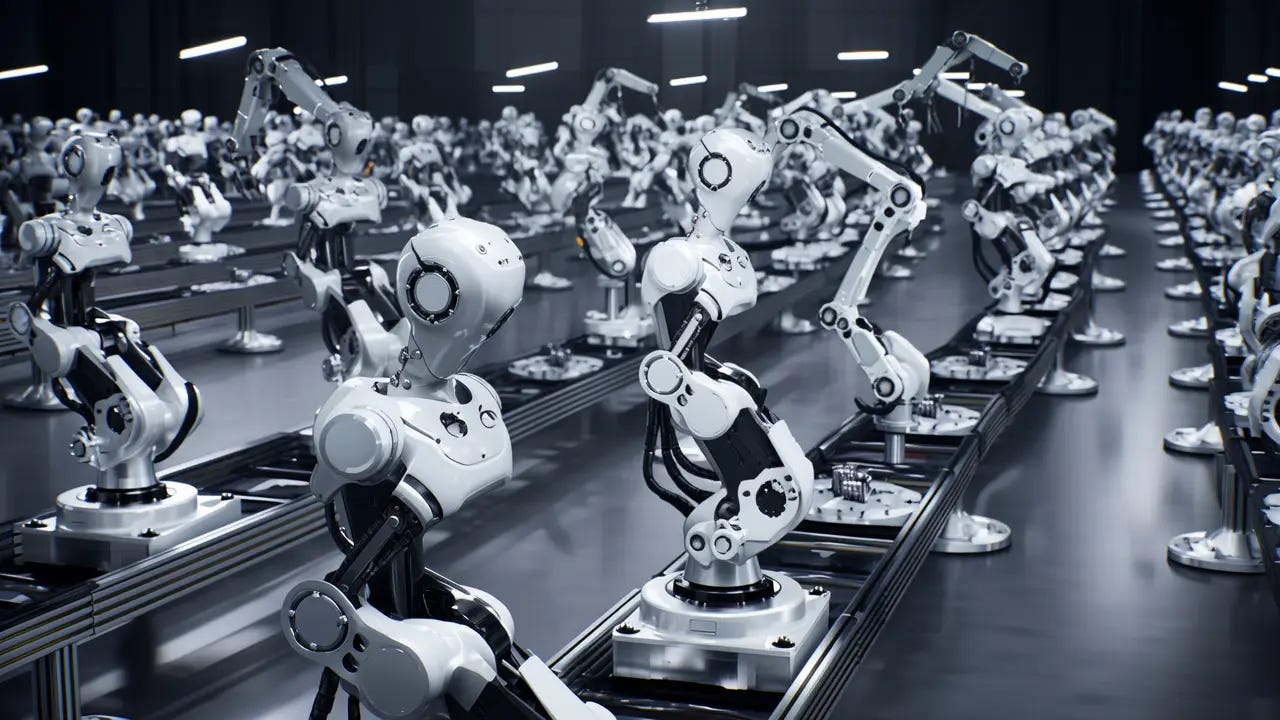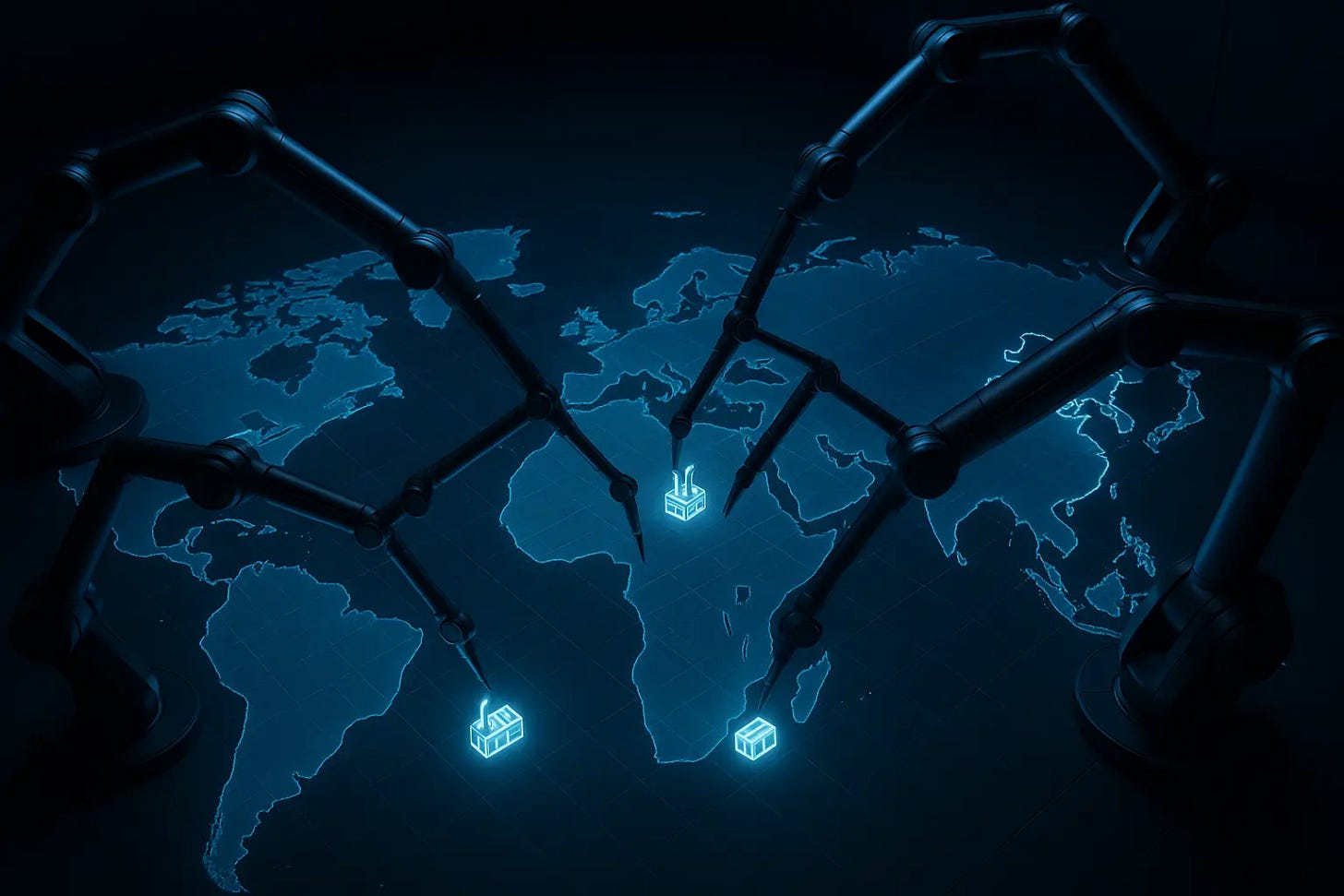The Robotic Divide: Inside China's State-Engineered Challenge to Silicon Valley
Hello China Tech by Poe Zhao – Weekly insights into China’s tech revolution. I analyze how developments in Chinese AI, electric vehicles, robotics, and semiconductors are reshaping global technology landscapes. Each piece contextualizes China’s innovations within worldwide market dynamics and strategic implications.
The global race for humanoid robots is being framed as a technological duel. But in China, it’s a calculated game of industrial strategy, one that leverages state capital, curated markets, and a brutal race to the bottom–and it follows a familiar script.
In mid-2025, a jarring dissonance defined China’s humanoid robotics landscape. While seasoned venture capitalists warned of a speculative bubble and began quietly exiting their positions, the state-owned behemoth China Mobile placed a landmark ¥124 million ($17 million) order with two fledgling startups. This was not market confusion. It was the clearest signal of a great divergence in the global race to build the machines that will define the 21st-century economy.
While Silicon Valley pursues a “moonshot” fueled by visionary entrepreneurs and big-tech alliances, China is executing a deliberate, state-influenced industrial campaign. It is a playbook that weaponizes capital markets, anoints national champions, and seeks to dominate not just the final product, but the entire supply chain. This competition is not merely about whose robot is most advanced; it is a fundamental clash of development philosophies. For those who watched China conquer the solar, 5G, and electric vehicle industries, its methods are becoming profoundly familiar.
The American Moonshot
The Western narrative for humanoid robotics is one of audacious, capital-intensive innovation. It was reignited by Elon Musk’s dramatic unveiling of the Tesla Optimus and accelerated by agile startups like Figure AI, which secured not only a commercial partnership with BMW but also a staggering $675 million from a consortium of tech royalty: Microsoft, OpenAI, Nvidia, and Amazon’s Jeff Bezos.The logic behind this American capital blitz is clear. This is ecosystem warfare. For Microsoft and OpenAI, robots are the physical avatars for their AI models. For Nvidia, they represent a vast new frontier for its chips. For Amazon, they are the key to automating global logistics. The shared goal is to establish a new “Wintel”-style standard for embodied intelligence, where a handful of American giants provide the indispensable cloud and AI backbone. It is a quintessential moonshot: high-risk, high-reward, and aimed at securing a paradigm-shifting technological leap.
China’s Playbook I: Forging Champions with Strategic Capital
Across the Pacific, China is playing a different game, where the most potent innovation is often financial and structural. The landscape is rapidly consolidating into a two-tiered system, a Great Robotic Bifurcation that separates a handful of state-backed champions from a sea of struggling contenders.
On one side are firms like Zhiyuan Robotics, UBTECH, and Galaxy General, whose funding rounds are underwritten by a who’s who of Chinese corporate and state power, including Tencent, Meituan, and a host of government-guided investment funds. On the other are hundreds of smaller players facing a venture-backed reckoning as the easy money dries up.
The tactics used to fuel these champions are ruthlessly pragmatic. Zhiyuan Robotics, a company barely two and a half years old, provided a masterclass in navigating regulatory bottlenecks with its “reverse takeover” of a publicly-listed company. This maneuver allowed it to bypass China’s notoriously long IPO queues, securing a precious foothold in the public markets. This is not an isolated incident but a symptom of a system driven by a deeper urgency: the tyranny of the ten-year fund cycle.
Many of the venture firms that backed China’s early robotics ventures are now legally obligated to liquidate their aging funds and return capital to investors. This has created an exodus driven by investor timelines, not corporate readiness, forcing a generation of deep-tech companies onto the unforgiving quarterly treadmill. For those lacking the clout for a reverse takeover, Hong Kong’s stock exchange and its Chapter 18C rule, designed for pre-revenue tech firms, has become a strategic flight to regulatory flexibility. It’s a clear-eyed choice to secure survival capital, even at the cost of a lower valuation or market volatility.
China’s Playbook II: The State as the First–and Best–Customer
If unconventional financing provides the fuel, the state’s role as a foundational customer de-risks the entire journey. The China Mobile contract was a watershed moment, illustrating a core tenet of China’s industrial policy: the creation of a state-curated market.
Such a deal provides far more than just revenue. It offers a crucial financial lifeline, allowing companies to weather the cash-intensive R&D phase without further equity dilution. More importantly, it grants access to an unparalleled, real-world training ground, providing the massive, proprietary datasets needed to refine AI models–a data moat no laboratory can replicate. Finally, it serves as a powerful political endorsement, a “seal of approval” from Beijing that signals to the entire ecosystem–from other state-owned enterprises to private suppliers–who the designated leaders are.
This approach stands in stark contrast to the West, where a deal like Figure AI’s with BMW represents validation by the market. In China, the state is creating and guaranteeing the market to ensure its chosen champions survive, scale, and eventually, dominate.
China’s Playbook III: The Race to the Bottom
With capital secured and initial demand curated, the third phase of the playbook begins: a brutal, intentional race to the bottom on price. This is where the strategy shifts from domestic consolidation to global ambition.
The harbinger of this phase is Unitree’s G1 robot, priced at a disruptive ¥99,000 (~$13,600)–a fraction of its competitors’ costs. This is not a simple discount; it is a strategic decision to prioritize market share and scale over initial perfection.
A look at the G1’s bill of materials reveals how this cost-first strategy is being executed at the component level. The base model is equipped with 23 frameless motors, each costing between ¥1,300 and ¥2,000. These motors alone account for ¥30,000 to ¥48,000, representing a staggering 32% to 49% of the robot’s total hardware cost. This granular data exposes the core battleground: the domestic supply chain for high-performance components. By relentlessly driving down the cost of the most expensive parts, Chinese firms are not just making robots cheaper; they are building a defensible moat in the manufacturing ecosystem that underpins the entire industry.
This is the most recognizable page from a well-worn script of state-sponsored industrial conquest. The pattern is consistent. First, the state identifies a strategic industry. Second, capital is channeled to national champions. Third, fierce domestic competition is encouraged, inciting a price war that drives down costs at an astonishing rate and forces consolidation across the entire supply chain. Finally, the battle-hardened winners, operating at immense scale, emerge to compete globally with low-cost, “good enough” technology.
This strategy is amplified by a unique ability to transform public spectacle into commercial velocity. Events like robotic marathons and boxing matches, while appearing technically unpolished to Western engineers, serve as brilliant, low-cost marketing campaigns. They generate enormous public interest and, crucially, tangible sales orders, creating a virtuous cycle where the commercial deployment of imperfect products directly funds their iterative improvement.
Reality Check: The Gap Between Ambition and Application
To be clear, China’s path is not without significant peril. A candid assessment of the sector reveals that beneath the polished demonstrations, the technical foundations remain uneven. Many systems still depend on imported high-end components, and their AI models are far from demonstrating the general-purpose intelligence required for complex, dynamic environments. A large portion of their current applications are in non-core tasks like marketing events or simple guidance roles.
The risk of a valuation bubble collapsing is real, and mainstream market tolerance for underperforming products is finite. However, to focus solely on these shortcomings is to miss the strategic intent. This is not a system designed for elegant, linear progression. It is a system engineered for chaotic, relentless, and rapid evolution at scale.
The Global Endgame
The implications of this robotic divide are profound. For Western manufacturers, the prospect of a flood of affordable, capable Chinese robots could fundamentally alter calculations on automation and labor costs. A robot designed in Shanghai may soon be the most cost-effective way to operate a factory in Stuttgart or Detroit.
For Western tech leaders like Tesla and Figure AI, the nature of the competition is changing. They are not merely competing against another company; they are competing against a state-backed industrial ecosystem engineered for speed, scale, and cost reduction. Their technological lead, while currently significant, may be eroded by the sheer volume of real-world data and iterative cycles that China’s model enables.
For policymakers, the race for robotics is a matter of supply chain resilience and strategic autonomy. The nation that masters the production of these machines will hold immense leverage over the future of global manufacturing. China’s “dual circulation” strategy–wherein its robotics firms increasingly integrate with domestic tech giants like Huawei for chips and operating systems–is a clear effort to build a self-reliant ecosystem, insulated from Western sanctions.
China is not just building robots; it is building the industrial base that builds the robots. It is doing so with a clear-eyed pragmatism that prioritizes market dominance over technical purity. While the West aims for a perfect moonshot, China is waging a war of attrition on the ground, content to win with imperfect machines that are simply good enough to conquer the factory floor. The clumsy robot stumbling through a marathon today may seem a curiosity. But backed by the world’s largest manufacturing base and driven by a relentless national strategy, it represents the blueprint for a future where the machines that build our world are predominantly made in China.
About Hello China Tech
I’m Poe Zhao, and I bridge the gap between China’s rapidly evolving tech ecosystem and the global community. Through Hello China Tech, I provide twice-weekly analysis that goes beyond headlines to examine the strategic implications of China’s technological advancement.
Found this useful?
→ Share this newsletter with colleagues who need to understand China’s tech impact
→ Subscribe for free to receive every analysis:
→ Follow the conversation on 𝕏 for daily updates and additional insights
Get in touch: Have questions about China’s tech sector or suggestions for future analysis? Reply to this email – I read every message.






